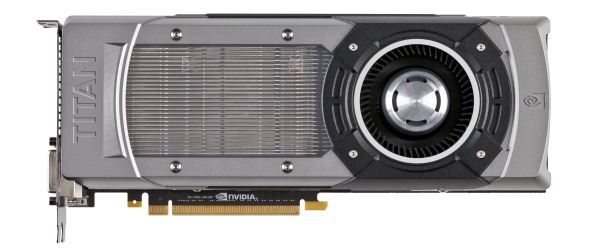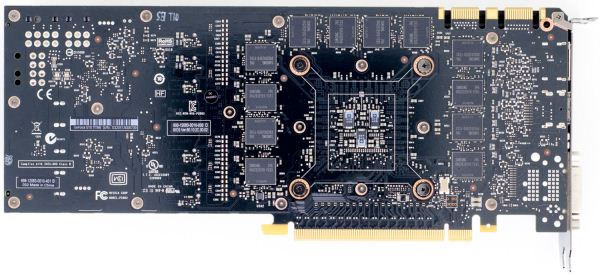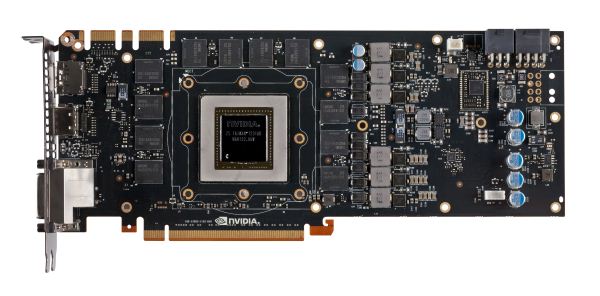NVIDIA's GeForce GTX Titan, Part 1: Titan For Gaming, Titan For Compute
by Ryan Smith on February 19, 2013 9:01 AM ESTMeet The GeForce GTX Titan
As we briefly mentioned at the beginning of this article, the GeForce GTX Titan takes a large number of cues from the GTX 690. Chief among these is that it’s a luxury card, and as such is built to similar standards as the GTX 690. Consequently, like the GTX 690, Titan is essentially in a league of its own when it comes to build quality.
Much like the GTX 690 was to the GTX 590, Titan is an evolution of the cooler found on the GTX 580. This means we’re looking at a card roughly 10.5” in length using a double-wide cooler. The basis of Titan’s cooler is a radial fan (blower) sitting towards the back of the card, with the GPU, RAM, and most of the power regulation circuitry in front of the fan. As a result the bulk of the hot air generated by Titan is blown forwards and out of the card. However it’s worth noting that unlike most other blowers technically the back side isn’t sealed, and while there is relatively little circuitry behind the fan, it would be incorrect to state that the card is fully exhausting. With that said, leaving the back side of the card open seems to be more about noise and aesthetics than it does heat management.
Like the GTX 580 but unlike the GTX 680, heat transfer is provided by a nickel tipped aluminum heatsink attached to the GPU via a vapor chamber. We typically only see vapor chambers on premium cards due to their greater costs, but also when space is at a premium. Meanwhile NVIDIA seems to be pushing the limits of heatsink size here, with the fins on Titan’s heatsink actually running beyond the base of the vapor chamber. Meanwhile providing the thermal interface between the GPU itself and the vapor chamber is a silk screened application of a high-end Shin-Etsu thermal compound; NVIDIA claims this compound offers over twice the performance of GTX 680’s grease, although of all of NVIDIA’s claims this is the least possible to validate.
Moving on, catching what the vapor chamber doesn’t cover is an aluminum baseplate that runs along the card, not only providing structural rigidity but also providing cooling for the VRMs and for the RAM on the front side of the card. Baseplates aren’t anything new for NVIDIA, but again this is something that we don’t see a lot of except on their more premium cards.
Capping off Titan we have its most visible luxury aspects. Like the GTX 690 before it, NVIDIA has replaced virtually every bit of plastic with metal for aesthetic/perceptual purposes. This time the entire shroud and fan housing is composed of casted aluminum, which NVIDIA tells us is easier to cast than the previous mix of aluminum and magnesium that the GTX 690 used. Meanwhile the polycarbonate window makes its return allowing you to see Titan’s heatsink solely for the sake of it.
As for the back side of the card, keeping with most of NVIDIA’s cards Titan runs with a bare back. The GDDR5 RAM chips don’t require any kind of additional cooling, and a metal backplate while making for a great feeling card, occupies precious space that would otherwise impede cooling in tight spaces.
Moving on, let’s talk about the electrical details of Titan’s design. Whereas GTX 680 was a 4+2 power phase design – 4 power phases for the GPU and 2 for the VRAM – Titan improves on this by moving to a 6+2 power phase design. I suspect the most hardcore of overclockers will be disappointed with Titan only having 6 phases for the GPU, but for most overclocking purposes this would seem to be enough.
Meanwhile for RAM it should come as no particular surprise that NVIDIA is once more using 6GHz RAM here. Specifically, NVIDIA is using 24 6GHz Samsung 2Gb modules here, totaling up to the 6GB of RAM we see on the card. 12 modules are on front with the other 12 modules on the rear. The overclocking headroom on 6GHz RAM seems to vary from chip to chip, so while Titan should have some memory overclocking headroom it’s hard to say just what the combination of luck and the wider 384bit memory bus will do.
Providing power for all of this is a pair of PCIe power sockets, a 6pin and an 8pin, for a combined total of 300W of capacity. With Titan only having a TDP of 250W in the first place, this leaves quite a bit of headroom before ever needing to run outside of the PCIe specification.
At the other end of Titan we can see that NVIDIA has once again gone back to their “standard” port configuration for the GeForce 600 series: two DL-DVI ports, one HDMI port, and one full-size DisplayPort. Like the rest of the 600 family, Titan can drive up to four displays so this configuration is a good match. Though I would still like to see two mini-DisplayPorts in the place of the full size DisplayPort, in order to tap the greater functionality DisplayPort offers though its port conversion mechanisms.














157 Comments
View All Comments
Wolfpup - Tuesday, February 19, 2013 - link
I think so too. And IMO this makes sense...no one NEEDS this card, the GTX 680 is still awesome, and still competitive where it is. They can be selling these elsewhere for more, etc.Now, who wants to buy me 3 of them to run Folding @ Home on :-D
IanCutress - Tuesday, February 19, 2013 - link
Doing some heavy compute, this card could pay for itself in a couple of weeks over a 680 or two. On the business side, it all comes down to 'does it make a difference to throughput', and if you can quantify that and cost it up, then it'll make sense. Gaming, well that's up to you. Folding... I wonder if the code needs tweaking a little.wreckeysroll - Tuesday, February 19, 2013 - link
Price is going to kill this card. See the powerpoints in the previews for performance. Titan is not too much faster than what they have on the market now, so not just the same price as a 690 but 30% slower as well.Game customers are not pro customers.
This card could of been nice before someone slipped a gear at nvidia and thought gamers would eat this $1000 rip-off. A few will like anything not many though. Big error was made here on pricing this for $1000. A sane price would of sold many more than this lunacy.
Nvidia dropped the ball.
johnthacker - Tuesday, February 19, 2013 - link
People doing compute will eat this up, though. I went to NVIDIA's GPU Tech Conference last year, people were clamoring for a GK110 based consumer card for compute, after hearing that Dynamic Paralleism and HyperQ were limited to the GK110 and not on the GK104.They will sell as many as they want to people doing compute, and won't care at all if they aren't selling them to gamers, since they'll be making more profit anyway.
Nvidia didn't drop the ball, it's that they're playing a different game than you think.
TheJian - Wednesday, February 20, 2013 - link
Want to place bet on them being out of stock on the day their on sale? I'd be shocked if you can get one in a day if not a week.I thought the $500 Nexus 10 would slow some down but I had to fight for hours to get one bought and sold out in most places in under an hour. I believe most overpriced apple products have the same problem.
They are not trying to sell this to the middle class ya know.
Asus prices the ares 2 at $1600. They only made 1000 last I checked. These are not going to sell 10 million and selling for anything less would just mean less money, and problems meeting production. You price your product at what you think the market will bare. Not what Wreckeysroll thinks the price should be. Performance like a dualchip card is quite a feat of engineering. Note the Ares2 uses like ~475watts. This will come in around 250w. Again, quite a feat. That's around ~100 less than a 690 also.
Don't forget this is a card that is $2500 of compute power. Even Amazon had to buy 10000 K20's just to get a $1500 price on them, and had to also buy $500 insurance for each one to get that deal. You think Amazon is a bunch of idiots? This is a card that fixes 600 series weakness and adds substantial performance to boot. It would be lunacy to sell it for under $1000. If we could all afford it they'd make nothing and be out of stock in .5 seconds...LOL
chizow - Friday, February 22, 2013 - link
Except they have been selling this *SAME* class of card for much <$1000 for the better part of a decade. *SAME* size, same relative performance, same cost to produce. Where have you been and why do you think it's now OK to sell it for 2x as much when nothing about it justifies the price increase?CeriseCogburn - Sunday, February 24, 2013 - link
LOL same cost to produce....You're insane.
Gastec - Wednesday, February 27, 2013 - link
You forget about the "bragging rights" factor. Perhaps Nvidia won't make many GTX Titan but all those they do make will definitely sell like warm bread. There are enough "enthusiasts" and other kinds of trolls out there (most of them in United States) willing to give anything to show to the Internet their high scores in various benchmarks and/or post a flashy picture with their shiny "rig".herzwoig - Tuesday, February 19, 2013 - link
Unacceptable price.Less than promised performance.
Pro customers will get a Tesla, that is what those cards are for with the attenuate support and drivers. Nvidia is selling this as a consumer gaming play card and trying to reshape the high end gaming SKU as an even more premium product (doubly so!!)
Terrible value and whatever performance it has going for it is erroded by the nonsensical pricing strategy. Surprising level of miscalculation on the greed front from nvidia...
TheJian - Wednesday, February 20, 2013 - link
They'll pay $2500 to get that unless they buy 10000 like amazon (which still paid $2000/card). Unacceptable for you, but I guess you're not their target market. You can get TWO of these for the price of ONE tesla at $2000 and ONLY if you buy 10000 like amazon. Heck if buying one Tesla, I get two of these, a new I7-3770K+ a board...LOL. They're selling this as a consumer card with telsa performance (sans support/insurance). Sounds like they priced it right in line with nearly every other top of the line card released for years in this range. 7990, 690 etc...on down the line.Less than promised performance? So you've benchmarked it then?
"Terrible value and whatever performance it has going for it"
So you haven't any idea yet right?...Considering a 7990 costs a $1000 too basically, and uses 475w vs. 250w, while being 1/2 the size this isn't so nonsensical. This card shouldn't heat up your room either. There are many benefits, you just can't see beyond those AMD goggles you've got on.